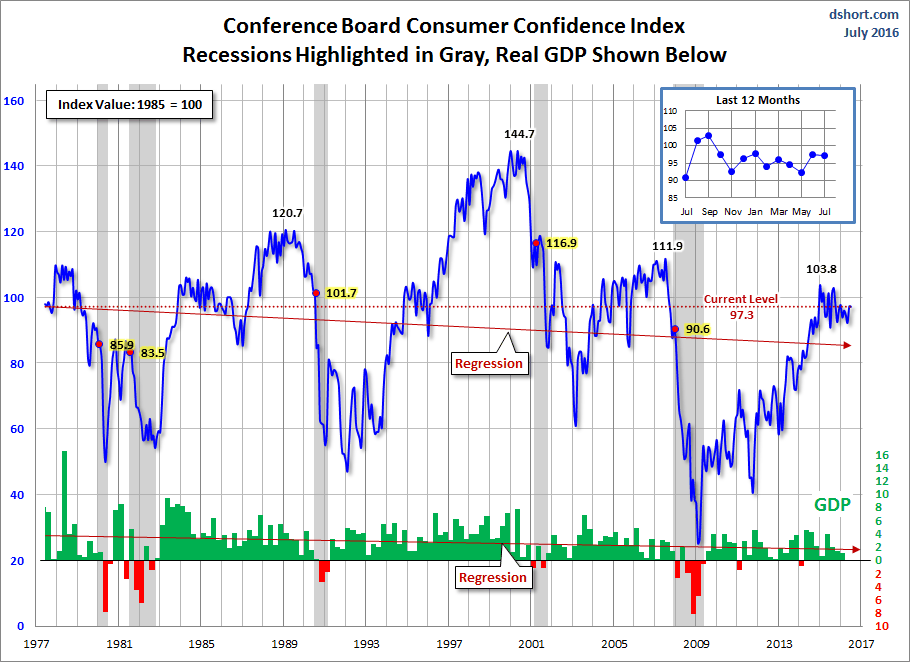Courtesy of Doug Short.
The Latest Conference Board Consumer Confidence Index was released this morning based on data collected through March 19. The headline number of 101.3 was a rise from the revised February final reading of 98.8, an upward revision from 96.4. Today’s number was above the Investing.com forecast of 96.0.
Here is an excerpt from the Conference Board press release.
Lynn Franco, Director of Economic Indicators at The Conference Board, said: “Consumer confidence improved in March after retreating in February. This month’s increase was driven by an improved short-term outlook for both employment and income prospects; consumers were less upbeat about business conditions. Consumers’ assessment of current conditions declined for the second consecutive month, suggesting that growth may have softened in Q1, and doesn’t appear to be gaining any significant momentum heading into the spring months.”
Consumers’ assessment of present-day conditions turned moderately less favorable for a second straight month. The percentage saying business conditions are “good” was unchanged at 26.7 percent, while those claiming business conditions are “bad” increased from 16.7 percent to 19.4 percent. Consumers were mixed in their assessment of the job market. The proportion stating jobs are “plentiful” edged up from 20.3 percent to 20.6 percent, while those claiming jobs are “hard to get” also edged up from 25.1 percent to 25.4 percent.
Consumers’ optimism about the short-term outlook, which had declined last month, rebounded in March. The percentage of consumers expecting business conditions to improve over the next six months decreased slightly, from 17.6 percent to 16.7 percent; however, those expecting business conditions to worsen also fell, from 8.9 percent to 8.0 percent.
Consumers’ outlook for the labor market saw stronger gains. Those anticipating more jobs in the months ahead increased from 13.8 percent to 15.5 percent, while those anticipating fewer jobs declined from 14.8 percent to 13.5 percent. The proportion of consumers expecting growth in their incomes improved from 16.4 percent to 18.4 percent, while the proportion expecting a drop declined from 10.8 percent to 9.9 percent.
Putting the Latest Number in Context
The chart below is another attempt to evaluate the historical context for this index as a coincident indicator of the economy. Toward this end I have highlighted recessions and included GDP. The regression through the index data shows the long-term trend and highlights the extreme volatility of this indicator. Statisticians may assign little significance to a regression through this sort of data. But the slope clearly resembles the regression trend for real GDP shown below, and it is a more revealing gauge of relative confidence than the 1985 level of 100 that the Conference Board cites as a point of reference.
On a percentile basis, the latest reading is at the 63rd percentile of all the monthly readings since the start of the monthly data series in June 1977.
For an additional perspective on consumer attitudes, see my post on the most recent Reuters/University of Michigan Consumer Sentiment Index. Here is the chart from that post.
And finally, let’s take a look at the correlation between consumer confidence and small business sentiment, the latter by way of the National Federation of Independent Business (NFIB) Small Business Optimism Index. As the chart illustrates, the two have tracked one another fairly closely since the onset of the Financial Crisis.






